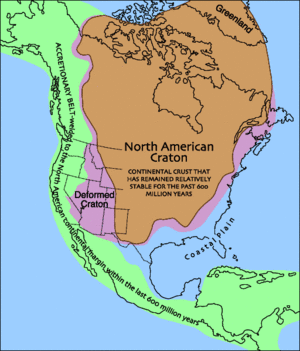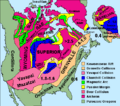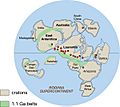Laurentia facts for kids

Laurentia is a huge, very old part of Earth's crust. Think of it as the ancient heart of the North American continent. It also includes parts of Greenland and northwestern Scotland.
Laurentia is also known as the North American Craton. A craton is a stable, very old part of the Earth's crust. It's made mostly of igneous rock, which forms when molten rock cools and hardens. Laurentia is almost four billion years old!
Over Earth's long history, Laurentia has been part of bigger landmasses called supercontinents. It formed from several smaller pieces of Earth's crust, called tectonic plates. These plates slowly came together during the early Archaean era. When they collided, huge mountain ranges were created.
Later, in the Proterozoic era, more small plates and islands in the ocean joined with Laurentia. This process made Laurentia even bigger and more stable. Today, it forms the northern and central parts of North America, plus western Greenland.
More than a billion years ago, a major mountain-building event called the Grenville Orogeny happened in the Canadian Shield. This created mountains taller than any we see today. But over millions of years, wind and water have worn them down into rolling hills.
The western part of North America was added much later. This happened after the supercontinent Pangaea broke apart. The Americas then moved west, separating from Eurasia and Gondwana.
The name Laurentia comes from the Laurentian Mountains. These mountains are located north of the St. Lawrence River.
What Rocks We See Today
The very old rocks of Laurentia are mostly metamorphic and igneous. Metamorphic rocks are rocks that have changed due to heat and pressure. Igneous rocks form from cooled magma or lava.
On top of these ancient rocks, you can find sedimentary rocks. These layers were laid down between 650 and 290 million years ago. They are mostly limestones, sandstones, and shales. In eastern and central Canada, much of this stable, ancient land is visible on the surface.
The southwestern part of Laurentia has very old Precambrian rocks. These rocks were shaped by continents colliding. This area has also been stretched apart, like in the Basin and Range Province. This stretching can make the land wider than it was before. This region also has a history of big volcanic eruptions.
Images for kids
See also
 In Spanish: Laurentia (continente) para niños
In Spanish: Laurentia (continente) para niños




